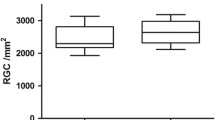Summary
The fate of India ink particles and polystyrene latex beads injected into the corneal stroma of rabbits was studied by the naked eye, light microscopy, and electron microscopy. All the injected ink particles or latex beads were unchanged in shape, size, and number for at least 6 months. India ink particles and latex beads were endocytosed by the corneal fibroblasts within 3–4 days after injection. Numerous ink particles were packed into vacuoles, 0.5–10 μm in diameter, which occupy a large volume of the cytoplasm of the cell body and processes of fibroblasts in and near the injected area. Each latex bead, 0.72 μm in diameter, is usually enclosed in one vesicle, and a large number of vesicles are distributed throughout the cytoplasm. In corneal tissue removed 10 min after injection of India ink and cultured for 3 or 7 days, uptake of many ink particles by the fibroblasts was seen. By this experiment, the contribution of the blood-derived cells was completely excluded, and it is more distinctly shown that the corneal fibroblast has a strong endocytotic activity.
The uptake and long-term storage of ink particles and latex beads by the corneal fibroblast are reactions that protect the organ without inflammation from the injury and harm by non-toxic foreign materials.
Similar content being viewed by others
References
Adler-Storthz K, Wilson LA, Smith JW (1983) Complement potentiation of phagocyte-mediated ADCC of HSV-infected corneal cells. Invest Ophthalmol Vis Sci 25:440–446
Berman M, Leary R, Gage J (1979) Collagenase from corneal cell cultures and its modulation by phagocytosis. Invest Ophthalmol Vis Sci 18:588–601
Furth R, van (1970) The origin and turnover of promonocytes, monocytes and macrophages in normal mice. In: van Furth R (ed) Mononuclear phagocytes. Blackwell, Oxford, pp 15–165
Furth R, van Cohn ZA, Hirsch JG, Humphrey JH, Spector WG, Langevoort HL (1972) The mononuclear phagocyte system: A new classification of macrophages, monocytes, and their precursor cell. Bull WHO 46:845–852
Fujita H, Kawamata S, Yamashita K (1983) Electron microscopic studies on multinucleate foreign body giant cells derived from Kupffer cells in mice given Indian ink intravenously. Virchows Arch (Cell Pathol) 42:33–42
Grinnell F (1980) Fibroblast receptor for cell-substratum adhesion: Studies on the interaction of baby hamster kidney cells with latex beads coated by cold insoluble globulin (plasma fibronectin). J Cell Biol 86:104–112
Hogan MJ, Alvarado JA, Weddell JE (1971) The cornea. In: Histology of the human eye. Saunders, Philadelphia, pp 55–111
Jakus MA (1954) Studies on the cornea. I. The fine structure of the rat cornea. Am J Ophthalmol 38:40–52
Jakus MA (1962) Further observation on the fine structure of the cornea. Invest Ophthalmol 1:202–225
Maurice DM (1969) The cornea and sciera. In: Davson H (ed) The eye. Academic Press, New York, pp 289–368
McAbee DD, Grinnell F (1983) Fibronectin-mediated binding and phagocytosis of polystyrene latex beads by baby hamster kidney cells. J Cell Biol 97:1515–1523
Tripathi RC, Tripathi BT (1982) Human trabecular endothelium, corneal endothelium, keratocytes, and scierai fibroblasts in primary cell culture: A comparative study of growth characteristics, morphology, and phagocytic activity by light and scanning electron microscopy. Exp Eye Res 35:611–624
Yamashita K, Fujita H, Kawamata S (1985) Fine structural and cytochemical aspects of granuloma formation derived from Kupffer cells in mice injected with latex particles. Arch Histol Jpn 48:315–326
Author information
Authors and Affiliations
Additional information
A part of this study was published in Kinki Daigaku Igaku Zasshi in Japanese as a Ph. D. thesis by Atsuko Ueda. This study was supported by grants from the Ministry of Education, Science and Culture, Japan, the Osaka Eye Bank, Osaka, Japan, and an intramural Research Fund of Kinki University, Japan
Rights and permissions
About this article
Cite this article
Fujita, H., Ueda, A., Nishida, T. et al. Uptake of India ink particles and latex beads by corneal fibroblasts. Cell Tissue Res. 250, 251–255 (1987). https://doi.org/10.1007/BF00219069
Accepted:
Issue Date:
DOI: https://doi.org/10.1007/BF00219069




